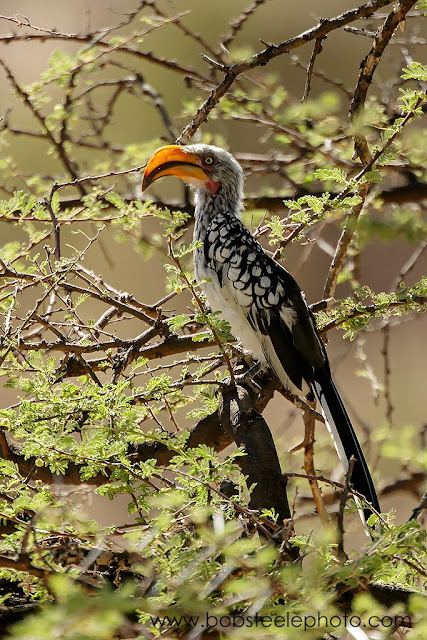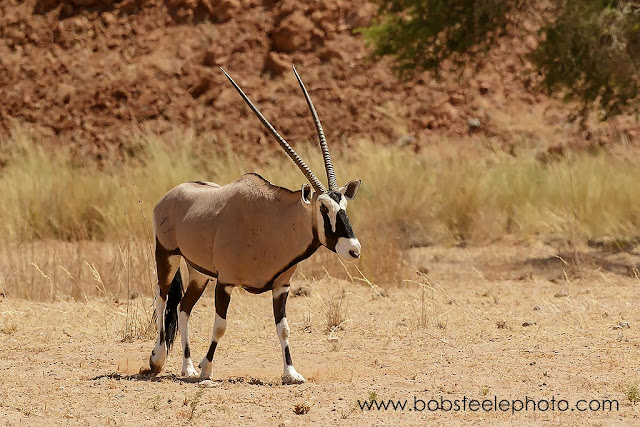Namibia is vast and arid, but has many birds including some near endemic species. The travel distances are large and the scenery magnificent so far. We started our trip in the capital city of Windhoek in the central plateau. It's high summer here and hot, but this is the prime birding season. Namibia has become a popular tourist destination and the hot weather keeps the crowds to a minimum. Good for us.
A couple of days birding Windhoek and the surrounding area added many great birds to our life lists.
Windhoek eBird list (as always, the included bird lists are only a representative sample of our sightings)
A morning outing to the nearby Daan Vilojen Game Reserve was a lot of fun and a great introduction to African birds and a few mammals.
 |
| Daan Vilojen Game Reserve |
 |
| Fork-tailed Drongo |
 |
| Scarlet-chested Sunbird |
 |
| Southern Masked Weaver |
 |
| Southern Yellow-billed Hornbill |
 |
| Violet-eared Waxbill |
From Windhoek our travel took us west across the highland plateau to the edge of the desert. Here the plateau escarpment drops away to the Namib Desert. We birded the escarpment for and afternoon and morning.
Namibgrens list
Spreetshootge Pass list
 |
| Sociable Weaver nests |
 |
| Driving toward the escarpment |
 |
| Common Fiscal |
 |
| Rufous-eared Warbler |
 |
| Spreetshootge Pass looking down to the Namib Desert |
 |
| Namib Desert from the pass |
 |
| Birding the pass |
 |
| Leopard Tortoise |
 |
| Klipspringer |
 |
| Klipspringer |
 |
| Greater Kestrel |
 |
| Grey Go-Away-Bird |
 |
| Shaft-tailed Whydah |
 |
| Southern Grey-headed Sparrow |
 |
| Herero Chat |
 |
| Karhoo Scrub Robin |
At over 1000 miles long, the coastal Namib Desert is the oldest in the world (80 million years), and has some of the driest areas on earth with vast sand areas and gravel plains. The geology and scenery were magnificent and the birding and mammals surprisingly excellent. Our lodge was quite lovely and made for a comfortable stay.
Namib Desert Lodge vicinity bird list
 |
| View from the lodge |
 |
| Southern Oryx |
 |
| Springbok |
 |
| Springbok |
 |
| Warthog |
 |
| Dusky Sunbird |
 |
| Southern Oryx |
 |
| Ludwig's Bustard |
 |
| Namaqua Sandgrouse |
 |
| Namaqua Sandgrouse |
 |
| Spike-heeled Lark |
Our morning playing in the red sand dunes is not one we will forget. These sand dunes can reach a thousand feet, the tallest in the world. Absolutely spectacular. The Namibia endemic Dune Lark was a special treat.
Sossusvlei bird list
 |
| Sunrise at the dunes |
 |
| Dune Lark |
 |
| Dune Lark habitat |
 |
| Oryx on a dune |
 |
| The Shovel-snouted Lizard is a dune specialist |
 |
| Southern Oryx hanging out in the shade |
After the dunes we explored Sesreim Canyon. This slot canyon of conglomerate rock is 100 feet deep and over a mile long.
From Sossusvlei we turned north and then west to cross to the coastal desert town of Walvis Bay. The scenery and birding along the way were quite amazing.
Bird list
 |
| A Mica Schist canyon |
 |
| Quiver Tree (an aloe) |
 |
| Quiver Tree |
 |
| Cape Bunting |
 |
| Double-banded Courser |
 |
| Gray's Lark |
 |
| Pale Chanting Goshawk |
 |
| Ruppell's Korhaan |
 |
| Ruppell's Korhaan |
 |
| Ruppell's Korhaan |
 |
| Stark's Lark |
 |
| Moringa Ovalifolia (Ghost Tree) |




















Wow. Thanks for taking the time to post these photos!! Some of them look like you could be on Mars. Truly mind boggling how those animals survive out there isn't it? Go Nature!
ReplyDeleteSo many questions arise - like why does that lark have spikes, whose foot prints are those in the sand, what is the geology, Oryx on the dune?
I am so glad that you are encountering so many wonderful places and wildlife.
Thank YOU.
Spectacular scenery plus a great photographer equals amazing photos. Thanks!
ReplyDelete